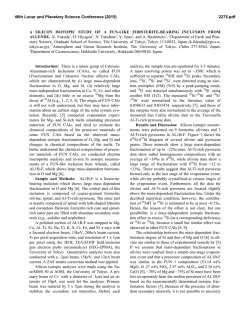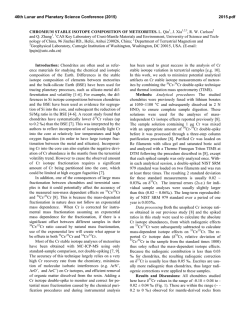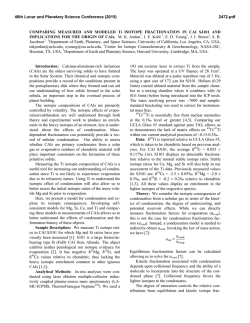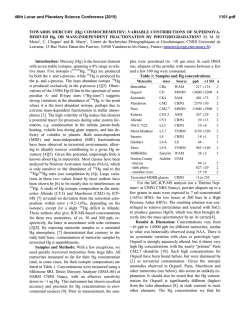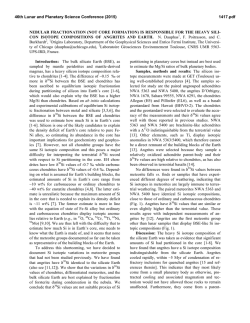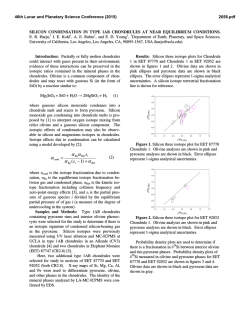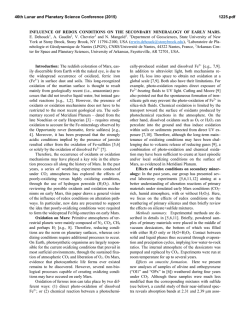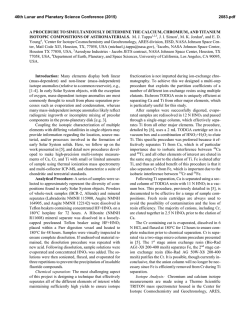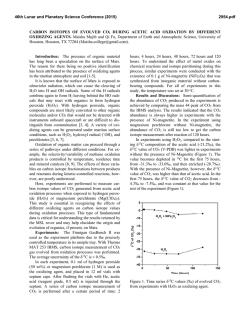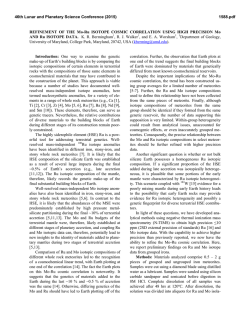
Iron Isotope Constraints on the Photo
46th Lunar and Planetary Science Conference (2015) 2635.pdf IRON ISOTOPE CONSTRAINTS ON THE PHOTO-OXIDATION PATHWAY TO BIF FORMATION. N. X. Nie1 and N. Dauphas1, 1Origins Lab, Department of the Geophysical Sciences and Enrico Fermi Institute, The University of Chicago, Chicago, IL 60637, USA ([email protected]). Introduction: Banded iron formations (BIFs) and associated lithologies are among the most important sedimentary rocks in the Archaean and Paleoproterozoic. They have been used to constrain the redox state, biological activity and seawater chemistry on the ancient Earth. BIFs consist of alternating thin layers of iron-rich minerals (most often magnetite and hematite) and iron-poor silica. The iron source was probably hydrothermal ferrous iron Fe(II) [1-3], which was oxidized into Fe(III) and precipitated. Several mechanisms have been considered to explain the oxidation of iron in an atmosphere/hydrosphere that was globaly anoxic. Some local “oxygen oasis” could have been produced by photosynthesis in cyanobacteria [4, 5]. Another biogenic alternative is that Fe(II) was used directly as electron donor by microorganisms during a process known as anoxygenic photosynthesis [6, 7]. However, definitive evidence of bacteria involvement in BIF formation is still missing [8], and a pure chemical process, photooxidation, has been proposed as a possible Fe(II) oxidation pathway [9, 10]. To investigate whether photooxidation could have played a role in BIF formation, we performed laboratory photo-oxidation experiment and measured Fe isotope fractionation during this process. Comparison of experiment results with BIF compositions allow us to test the viability of photooxidation as an oxidation pathway in the Archean ocean. Methods: About 350 mL of H3BO3-NaOH buffer solution at a pH of ~7.3 was added to a 500 mL borosilicate glass reaction vessel, and bubbled with highpurity argon gas (O2 < 0.1 ppm) for 3-4 h. After the dissolved oxygen was fully evicted, Fe(II) was introduced through one of the three inlets to the reaction vessel by dissolving salts of (NH4)2Fe(SO4)2.6H2O in deoxygenated water. The final concentration of the Fe(II) was around 100 ppm, or 1.8 mM, which is equivalent to the Fe production of some modern deep sea vents [11]. A 450 watt Hanovia medium pressure Hg lamp was inserted into the center of the reaction vessel to irradiate the Fe(II) solution. The lamp delivered a broad UV spectrum of 220-1370 nm. Around the lamp, an immersion well connected to a chiller was used to keep the system from over-heating. A thermometer was inserted into one of the inlets of the reaction vessel to monitor temperature. One inlet to the reaction vessel was used to sample the solutions. One sample consisted of ~ 7 mL solution aliquot taken with a syringe. A sample was taken before turning on the UV lamp. Another four 7 mL solutions were collected at different times after the UV lamp was turned on. The time interval between samples was about 30 min. While still in an anoxic atmosphere, the samples were filtered with 0.1 μm Sartorius™ Minisart™ HF syringe filters to separate aqueous Fe(II) from Fe(III) precipitates. The collected Fe(II) and Fe(III) samples were dried and re-dissolved in 6 M HCl. Iron column chemistry was done to eliminate matrix elements. Analyses of Fe isotopic compositions were performed with a Thermo Scientific Neptune Plus MC-ICPMS at the University of Chicago using previously established methods [12]. Results: Fe(II) concentration dropped from 90 ppm to 15 ppm over a 2 hour duration, pH decreased by ~0.2 units, and temperature increased from room temperature to 45 °C. Orange-coloured Fe(III) particles formed and precipitated. The three-isotope plot of Fe(II) samples, Fe(III) samples, and geostandard BIR1a and AGV-2 give a fractionation line with a slope of 1.47 for δ' 57Fe vs. δ' 56Fe (Fig. 1). Ferric iron samples plot on the heavy isotope-rich side of the line while Fe(II) samples fall on the other side. The δ56Fe values of both Fe(II) and Fe(III) decreased as the experiment proceeded. Throughout the experiment, the δ56Fe values of the Fe(II) solutions and Fe(III) precipitates exhibit apparent Rayleigh-type behavior, as shown in Fig. 2. The isotope fractionation between Fe(III) precipitates and aqueous Fe(II) for the overall reaction is 1.2 ‰. Discussion: In our experiment, Fe(III) precipitates were always enriched in the heavy isotopes of iron, which is consistent with results reported in an earlier paper [13] for low-pH photo-oxidation of aqueous Fe(II). However, the fractionation factor α (~1.0025 at 41 °C) measured by them is notably higher than ours (~1.0012 at 45 °C). The difference might be due to the different photo-oxidation mechanisms at distinct pH conditions with different ligands in solutions. The fact that the solution and precipitates follow a Rayleigh fractionation model demonstrates that the produced Fe(III) precipitates do not exchange or significantly exchange with the Fe(II) solution after formation. The 1.2 ‰ fractionation between Fe(III) particles and aqueous Fe(II) is similar to that obtained in anoxygenic photosynthetic oxidation of Fe(II) (~1.5 46th Lunar and Planetary Science Conference (2015) 2635.pdf ‰) [14] and in O2-mediated oxidation (~1 ‰) [15]. Since the hydrothermal fluids have zero or slightly negative δ56Fe values [16], all the three fractionation factors would result in isotopic compositions for Fe(III) precipitates that cover the range of values measured in BIFs. Therefore, there is still no unambiguous isotope evidence indicating that BIFs formed either microbially or photochemically. Fig. 3: Mass-dependent isotope fractionation lines for different laws, expressed as deviations from exponential law (n = 0), n = -1 for equilibrium law, n = 1 for power law, and n = -1/2 for Rayleigh law. Olive squares are the data points obtained from the photooxidation experiment. Fig. 1: Mass-dependent isotope fractionation line for Fe photo-oxidation. δ' is calculated as ln (δ /1000 + 1). Fig. 2: Rayleigh fractionation behavior of the photooxidation samples. Predicted trendlines for both Rayleigh and equilibrium fractionation are shown. 1.0012 was used as the Rayleigh fractionation factor (α). For equilibrium fractionation trends, a fractionation of 1.69 ‰ between Fe(III) and Fe(II) was used. A possible way to isotopically test the Fe oxidation mechanisms would be to use mass fractionation laws, because different geological processes may follow different laws. Fig. 3 shows possible Fe isotope fractionation laws. Due to the large error bars of the current measurements, the underlying law cannot be clearly recognized. Further work must be done to reduce the errors and to measure the isotopic compositions of BIFs with high precision. Conclusion: Our experiment reveals that Fe(III) oxides in BIFs could have been produced by photooxidation, a completely abiotic process. The process follows a Rayleigh fractionation model, and isotope fractionation between Fe(III) precipitates and aqueous Fe(II) for the overall reaction is ~1.2 ‰ at 45 °C. This fractionation is similar to that of anoxygenic photosynthetic oxidation and of O2-mediated oxidation, and therefore cannot be ruled out as a possible pathway to BIF formation. The only argument put forward against photo-oxidation [17] is curcumstantial and a more direct demonstration of the involvement of biology in BIF precipitation is still missing. References: [1] Holland H. D. (1973) Econ. Geol., 68, 1169–1172. [2] Jacobsen S. B. and Pimentel-Klose M. R. (1988) EPSL, 87, 29–44. [3] Bau M. et al. (1997) J. Geol., 121–129. [4] Cloud P. E. (1965) Science, 148, 27–35. [5] Cloud P. (1973) Econ. Geol., 68, 1135–1143. [6] Garrels R. M. et al. (1973) Econ. Geol., 68, 1173–1179. [7] Widdle F. (1993) Nature, 362, 834–836. [8] Klein C. (2005) Am. Mineral., 90, 1473–1499. [9] Cairns-Smith A. G. (1978) Nature, 276, 807–808. [10] Braterman P. S. et al. (1983) Nature, 303, 163–164. [11] Edmond J. M. et al. (1982) Nature, 297, 187–191. [12] Dauphas N. et al. (1982) Chem. Geol., 267, 175–184. [13] Staton S. et al. (2006) AGU, Abstract #V44A-04. [14] Croal L. R. et al. (2004) GCA, 68, 1227–1242. [15] Bullen T. D. et al. (2001) Geology, 29, 699–702. [16] Dauphas N. et al. (2004) Science, 306, 2077–2080. [17] Konhauser, K. O. et al. (2007) EPSL, 258, 87–100.
© Copyright 2026
